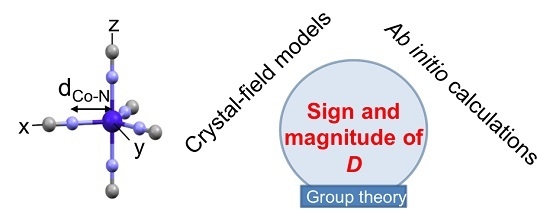1
Institut de Chimie Moléculaire et des Matériaux d’Orsay, CNRS, Université Paris Sud, Université Paris Saclay, 91405 Orsay Cedex, France
2
SUBATECH, UMR CNRS 6457, IN2P3/EMN Nantes/Université de Nantes, 4 rue A. Kastler, BP 20722, 44307 Nantes Cedex 3, France
3
Laboratoire de Chimie et Physique Quantiques, Université Toulouse III, 118 route de Narbonne, 31062 Toulouse, France
*
Authors to whom correspondence should be addressed.
Academic Editors: Marius Andruh and Liviu F. Chibotaru
Received: 30 April 2016 / Revised: 30 June 2016 / Accepted: 15 July 2016 / Published: 3 August 2016
(This article belongs to the Special Issue Magnetic Anisotropy)
Abstract
This work addresses the question of the identification of the excited states that are mainly responsible for the magnitude and nature of the magnetic anisotropy in high-spin mononuclear transition metal complexes. Only few states are actually responsible for the single ion magnetic anisotropy, and these states can be anticipated from rather simple rules. We show that in high-spin complexes atomic selection rules still prevail and that molecular selection rules from the symmetry point group are more selective than those of the double group. The predictive power of these rules is exemplified on a penta-coordinate Co(II) complex investigated with correlated ab initio calculations, including relativistic contributions. The electronic structure of excited states coupled to the ground state through spin-orbit coupling informs us about the nature (either axial or planar) of their contribution to the anisotropy. From this information, it is possible to anticipate the nature and strength of the ligand field and predict the magnetic anisotropy, which may guide the synthesis of improved anisotropic complexes. Such results can also be used to improve the quality of ab initio calculations of the spin Hamiltonian parameters and to reduce the computational cost.View Full-Text
Keywords: magnetic anisotropy; transition metal complexes; ab initio calculations; spin-orbit coupling
▼ Figures
This is an open access article distributed under the Creative Commons Attribution License which permits unrestricted use, distribution, and reproduction in any medium, provided the original work is properly cited. (CC BY 4.0).
http://www.mdpi.com/2312-7481/2/3/31






No comments:
Post a Comment